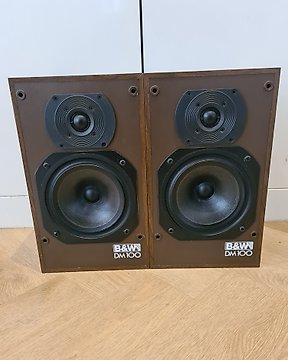
Bower & Wilkins - DM-100 - Ensemble d’enceintes
Nº 83277629

Nº 83277629

The DM4 is a three unit monitor loudspeaker comprising a highly developed Bextrene coned midbass unit (DW200/4, designed and produced by B&W), a Celestion HF1300 MkII lower high frequency unit (used also on the BBC LS3/6 and on the Spendor BC1) and a Coles 4001 19mm plastic domed supertweeter (also found on the Spendor BC1/SP1, IMF, Cambridge R50, B&W DM2 and DM2a).
To be more precise, two types of bass units were made, early ones had a white surround (tend to age badly, shrink and cones go off centre) and a later black surround. The crossover network was a third order 18 dB/oct Butterworth filter (3,5kHz-14kHz), and claimed frequency response extended from 30 Hz to above 25 kHz (±2dB). Actually, when measured in axis in an anechoic chamber, the frequency response was just 80Hz-20kHz ±5dB and 140Hz-14kHz ±3dB. Nominal impedance was 8 Ohm, with a minimum at 6 ohm (200 Hz) and a maximum at 25 ohm (∼2000 Hz). The DM4 monitor was individually tested in B&W's anechoic chamber and supplied with automatic pen plot showing frequency response.
Acoustic loading was by a very dense, critically damped enclosure with a small controlling vent to optimise the response between 60 and 120Hz. Not exactly a bass reflex, indeed. The cabinet was constructed of 19mm 750 density chip-board throughout, with inside balancing veneers. Inner surfaces of cabinet were absorbent lined, with the addition of long fibre natural wool, in order to reduce standing waves, reflections and colouration from the enclosure to a minimum. Binding posts accept only bananas, bare wire or forks are not allowed.
Available finishes were: teak, walnut or rosewood, plus a rare and unusual satin white finish or black ash. Claimed sensitivity was 95 dB with 4.8 watts on 8 ohm, at one metre, at 400Hz. This is not the usual modern standard measurement (dB/w/m) so it can be said the DM4 were sub-90 dB/w/m speakers. Hence, the claim - often found on the Web - the DM4 were “high sensitivity” speakers is based on a wrong assumption. They were not 95 dB/w/m!
Power handling might seem ridiculously low by today's standards, but it was considered quite an achievement at the time: indeed, amplifiers from 10 to 30 watts RMS were suggested.
Dimensions: height 531mm (21"), width 254mm (10"), depth 255mm (10"); weight: 11.1kg (24 lbs 6oz)
Beautiful speakers, see pictures for the optical state. Comes with manual.
To deliver this product properly, it is carefully packed in very strong boxes, thereby wrapped in bubble wrap with lots of padding. We mainly use plastic to fill up the package, if wished differently please contact us. The package is shipped insured to protect both the buyer and seller. For further packing wishes please message after purchase. Photos serve as additional description of product condition / condition of display & LEDs. Please review them carefully before purchase. Orders to islands, or special destinations have a higher shipping cost, for example; Canary Islands
Comment acheter sur Catawiki ?
1. Découvrez des objets d’exception
2. Faites la meilleure offre
3. Effectuez un paiement sécurisé